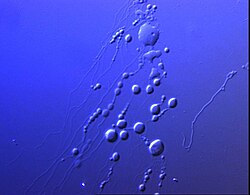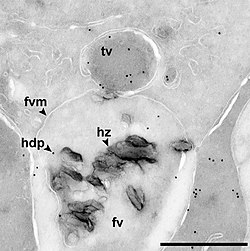Vesicle (biology and chemistry)
In
Vesicles perform a variety of functions. Because it is separated from the cytosol, the inside of the vesicle can be made to be different from the cytosolic environment. For this reason, vesicles are a basic tool used by the cell for organizing cellular substances. Vesicles are involved in metabolism, transport, buoyancy control,[2] and temporary storage of food and enzymes. They can also act as chemical reaction chambers.

Closed structure formed by amphiphilic molecules that contains solvent (usually water).[3]
The 2013
Types of vesicular structures

Vacuoles
- Plant cells have a large central vacuole in the center of the cell that is used for osmotic control and nutrientstorage.
- Ciliophora. These vacuoles take water from the cytoplasm and excrete it from the cell to avoid bursting due to osmotic pressure.
Lysosomes
- Lysosomes are involved in cellular digestion. Food can be taken from outside the cell into food vacuoles by a process called endocytosis. These food vacuoles fuse with lysosomes which break down the components so that they can be used in the cell. This form of cellular eating is called phagocytosis.
- Lysosomes are also used to destroy defective or damaged organelles in a process called autophagy. They fuse with the membrane of the damaged organelle, digesting it.
Transport vesicles
- Transport vesicles can move molecules between locations inside the cell, e.g., proteins from the rough endoplasmic reticulum to the Golgi apparatus.
- Membrane-bound and secreted proteins are made on peroxisomes, or outside of the cell. These proteins travel within the cell inside of transport vesicles.
Secretory vesicles
Types
- presynaptic terminals in neurons and store neurotransmitters. When a signal comes down an axon, the synaptic vesicles fuse with the cell membrane releasing the neurotransmitter so that it can be detected by receptormolecules on the next nerve cell.
- In animals, contains many cell types that are defined by which hormones they produce.
- Secretory vesicles hold the enzymes that are used to make the animal cells.
- Bacteria, archaea, fungi and parasites release membrane vesicles (MVs) containing varied but specialized toxic compounds and biochemical signal molecules, which are transported to target cells to initiate processes in favour of the microbe, which include invasion of host cells and killing of competing microbes in the same niche.[6]
Extracellular vesicles
Types
- Ectosomes/microvesicles are shed directly from the plasma membrane and can range in size from around 30 nm to larger than a micron in diameter[9]: Table 1 ). These may include large particles such as apoptotic blebs released by dying cells,[10][9]: Table 1 large oncosomes released by some cancer cells, or "exophers," released by nematode neurons[11]and mouse cardiomyocytes.
- Exosomes: membranous vesicles of endocytic origin (30-100 nm diameter).[9]: Table 1
Different types of EVs may be separated based on density[9]: Table 1 (by gradient differential centrifugation), size, or surface markers.[12] However, EV subtypes have an overlapping size and density ranges, and subtype-unique markers must be established on a cell-by-cell basis. Therefore, it is difficult to pinpoint the biogenesis pathway that gave rise to a particular EV after it has left the cell.[8]
In humans, endogenous extracellular vesicles likely play a role in coagulation, intercellular signaling and waste management.[9] They are also implicated in the pathophysiological processes involved in multiple diseases, including cancer.[13] Extracellular vesicles have raised interest as a potential source of biomarker discovery because of their role in intercellular communication, release into easily accessible body fluids and the resemblance of their molecular content to that of the releasing cells.[14] The extracellular vesicles of (mesenchymal) stem cells, also known as the secretome of stem cells, are being researched and applied for therapeutic purposes, predominantly degenerative, auto-immune and/or inflammatory diseases.[15]
In Gram-negative bacteria, EVs are produced by the pinching off of the outer membrane; however, how EVs escape the thick cell walls of Gram-positive bacteria, mycobacteria and fungi is still unknown. These EVs contain varied cargo, including nucleic acids, toxins, lipoproteins and enzymes and have important roles in microbial physiology and pathogenesis. In host–pathogen interactions, gram negative bacteria produce vesicles which play roles in establishing a colonization niche, carrying and transmitting virulence factors into host cells and modulating host defense and response.[16]
Ocean cyanobacteria have been found to continuously release vesicles containing proteins, DNA and RNA into the open ocean. Vesicles carrying DNA from diverse bacteria are abundant in coastal and open-ocean seawater samples.[17]
Protocells
The
Other types
Gas vesicles are used by archaea, bacteria and planktonic microorganisms, possibly to control vertical migration by regulating the gas content and thereby buoyancy, or possibly to position the cell for maximum solar light harvesting. These vesicles are typically lemon-shaped or cylindrical tubes made out of protein;[19] their diameter determines the strength of the vesicle with larger ones being weaker. The diameter of the vesicle also affects its volume and how efficiently it can provide buoyancy. In cyanobacteria, natural selection has worked to create vesicles that are at the maximum diameter possible while still being structurally stable. The protein skin is permeable to gases but not water, keeping the vesicles from flooding.[2]
Multivesicular body, or MVB, is a membrane-bound vesicle containing a number of smaller vesicles.[citation needed]
Formation and transport
Animal cell diagram | |
|---|---|
 Components of a typical animal cell:
|
Some vesicles are made when part of the membrane pinches off the endoplasmic reticulum or the Golgi complex. Others are made when an object outside of the cell is surrounded by the cell membrane.[citation needed]
Vesicle coat and cargo molecules
The vesicle "coat" is a collection of proteins that serve to shape the curvature of a donor membrane, forming the rounded vesicle shape. Coat proteins can also function to bind to various transmembrane receptor proteins, called cargo receptors. These receptors help select what material is endocytosed in receptor-mediated endocytosis or intracellular transport.
There are three types of vesicle coats:
The clathrin coat is thought to assemble in response to regulatory G protein. A protein coat assembles and disassembles due to an ADP ribosylation factor (ARF) protein.
Vesicle docking
Surface proteins called
Often SNAREs associated with vesicles or target membranes are instead classified as Qa, Qb, Qc, or R SNAREs owing to further variation than simply v- or t-SNAREs. An array of different SNARE complexes can be seen in different tissues and subcellular compartments, with 36 isoforms currently identified in humans.[citation needed]
Regulatory Rab proteins are thought to inspect the joining of the SNAREs. Rab protein is a regulatory GTP-binding protein and controls the binding of these complementary SNAREs for a long enough time for the Rab protein to hydrolyse its bound GTP and lock the vesicle onto the membrane.
Vesicle fusion
Vesicle fusion can occur in one of two ways: full fusion or
In receptor downregulation
Membrane proteins serving as
It is because of these vesicles that the endosome is sometimes known as a multivesicular body. The pathway to their formation is not completely understood; unlike the other vesicles described above, the outer surface of the vesicles is not in contact with the cytosol.
Preparation
Isolated vesicles
Producing membrane vesicles is one of the methods to investigate various membranes of the cell. After the living tissue is crushed into
Vesicles are mainly used in two types of research:
- To find and later isolate membrane receptors that specifically bind hormones and various other important substances.[24]
- To investigate transport of various ions or other substances across the membrane of the given type.[25] While transport can be more easily investigated with patch clamp techniques, vesicles can also be isolated from objects for which a patch clamp is not applicable.
Artificial vesicles
Artificial vesicles are classified into three groups based on their size: small unilamellar liposomes/vesicles (SUVs) with a size range of 20–100 nm, large unilamellar liposomes/vesicles (LUVs) with a size range of 100–1000 nm and giant unilamellar liposomes/vesicles (GUVs) with a size range of 1–200 µm.[26] Smaller vesicles in the same size range as trafficking vesicles found in living cells are frequently used in biochemistry and related fields. For such studies, a homogeneous phospholipid vesicle suspension can be prepared by extrusion or sonication,[27] or by rapid injection of a phospholipid solution into an aqueous buffer solution.[28] In this way, aqueous vesicle solutions can be prepared of different phospholipid composition, as well as different sizes of vesicles. Larger synthetically made vesicles such as GUVs are used for in vitro studies in cell biology in order to mimic cell membranes. These vesicles are large enough to be studied using traditional fluorescence light microscopy. A variety of methods exist to encapsulate biological reactants like protein solutions within such vesicles, making GUVs an ideal system for the in vitro recreation (and investigation) of cell functions in cell-like model membrane environments.[29] These methods include microfluidic methods, which allow for a high-yield production of vesicles with consistent sizes.[30]
See also
- Bleb (cell biology)
- Host–pathogen interaction
- Membrane contact sites
- Membrane nanotube
- Membrane vesicle trafficking
- Micelle
- Microsome
- Protocell
- Spitzenkörper, a structure of many small vesicles found in fungal hyphae
References
- PMID 23432972.
- ^ PMID 8177173.
- S2CID 96812603.
- ^ "Nobel medical prize goes to 2 Americans, 1 German". CNN. 2005-10-19. Retrieved 2013-10-09.
- ^ 2013 Nobel Prize in Physiology or Medicine, press release 2013-10-07
- PMID 22409932.
- PMID 25979354.
- ^ PMID 30637094.
- ^ S2CID 7764903. Free full text
- PMID 26564379.
- PMID 28178240.
- PMID 28326170.
- S2CID 2746182.
- S2CID 4876604.
- S2CID 18640402.
- PMID 16291643.
- S2CID 206551356.
- ^ a b Adamala K, Szostak JW. Nonenzymatic template-directed RNA synthesis inside model protocells. Science. 2013 Nov 29;342(6162):1098-100. doi: 10.1126/science.1241888. PMID 24288333; PMCID: PMC4104020
- S2CID 9926129.
- PMID 6061727.
- PMID 4195919.
- PMID 27860488.
- S2CID 1344520.
- PMID 18518965.
- .
- S2CID 30723166.
- PMID 889789.
- PMID 4738145.
- S2CID 232131463.
- PMID 30934758.
Further reading
- Alberts, Bruce; et al. (1998). Essential Cell Biology: An Introduction to the Molecular Biology of the Cell. Garland Pub. ISBN 978-0-8153-2971-8.
